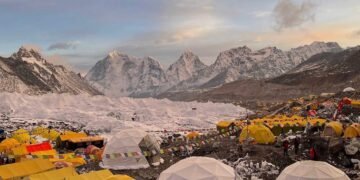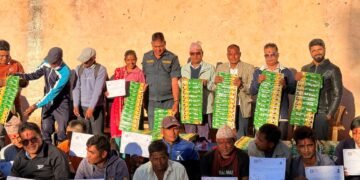Dr Raju Thapa
Vice-Chair, DPNet
Kathmandu, Jan 16: The Jajarkot earthquake, a devastating event with a magnitude of 6.4 on the Richter scale, struck on the night of November 3, 2023, at 23:47 PM. This calamity resulted in the tragic loss of 154 lives and left 60,478 households in complete ruins.
The earthquake’s timing during a cold winter exacerbated the situation, with 36 people succumbing to the harsh conditions while living under tarpaulins. The federal government’s immediate response was to provide support for building temporary shelters in the affected areas.
However, the distribution of funds was hindered by several challenges: the absence of local government officials, limited banking services, documentation errors, absenteeism of house owners residing outside Nepal, and the requirement to open new bank accounts, neglecting those linked to social security allowance bank account.
The situation was further complicated by an increase in applicants for reconstruction grants and disputes over eligibility criteria, such as treating multiple families living in the same house as a single unit for grant purposes.
These delays have caused significant hardships, especially for vulnerable groups like the elderly, pregnant and lactating women, children, people with chronic illnesses, and those with disabilities, who continue to endure the bitter cold. Two and a half months after the earthquake, over 62% of affected families are still living in makeshift shelters including simple tarpaulin due to the slow progress in constructing temporary shelters.
As Nepal observes Earthquake Safety Day on January 16th, it is crucial for the government and stakeholders to prepare for a potential mega earthquake. Historical records suggest that western Nepal is overdue for a significant seismic event, having not experienced a major earthquake since 1505. This region is at risk of an earthquake exceeding a magnitude of 8, which would be at least 251 times more powerful than the Jajarkot earthquake.
In contrast, the Bajhang earthquake, also measuring 6.3 on the Richter scale, occurred during the day and was preceded by a smaller quake 5.3 just before 26 minutes, allowing people to evacuate to safety. This resulted in only one casualty, caused by a landslide triggered by the earthquake, despite the complete destruction of 2,445 houses.
This highlights the critical need for an effective earthquake early warning system in Nepal. Despite a Supreme Court directive and ongoing advocacy efforts, significant progress in establishing such a system has not been made.
An early warning system, even providing a 10 to 20-second lead time, could be instrumental in saving lives and property during earthquakes. However, it appears that the Nepal government prioritizes spending on rescue, relief, and recovery rather than on preparedness and mitigation.
These recent earthquakes highlight the urgent need to address existing vulnerabilities, particularly in rural western Nepal where many homes are built with mud and round stones, without adherence to building codes or engineering principles.
In the face of such imminent threats, it is imperative to either retrofit or rebuild these vulnerable structures. The tragic aftermath of the Jajarkot earthquake serves as a big reminder of the importance of disaster preparedness and the dire consequences of delayed responses and lack of infrastructure.
It calls for a concerted effort from the government, local communities, and international stakeholders to invest in earthquake-resistant infrastructure and early warning systems to mitigate the impact of future seismic events.
The response to Jajarkot earthquake, has highlighted several areas for improvement in disaster management and preparedness. A key lesson learned is the necessity of a unified, legally binding form to track and coordinate disaster relief activities.
Such a form would detail the participants, actions, locations, timings, and reasons for relief efforts, enhancing transparency and accountability. This is crucial for efficient resource utilization and avoiding duplication of efforts. The government’s One Door policy needs clearer guidelines for cash and kind distribution and a more structured framework, especially when disasters affect multiple districts or provinces.
This policy should be adaptable to escalate coordination to provincial or federal levels as required. Another challenge is the inequitable distribution of aid, often due to humanitarian partners focusing on designated operational areas. An effective One Door system should encourage these partners to extend their support beyond their usual scope, ensuring balanced aid distribution.
Additionally, the current practice of not accepting Social Security Allowance accounts for disaster relief purposes is an obstacle for beneficiaries. The government should allow these accounts to be used for receiving grants, simplifying the process for those affected.
Administrative changes, like the appointment of a new Chief Administrative Officer in local government, often lead to delays in aid distribution. Nearly two months have passed since the Federal Government allocated funds to local governments for assisting earthquake-affected individuals, yet many beneficiaries, especially those living under tarpaulins, have yet to receive financial support to construct temporary shelters.
A notable instance of this delay is in Banphikot Rural Municipality, where the distribution of funds has been significantly hindered. The primary cause of this stall is the prolonged absence of the new Chief Administrative Officer (CAO). As a result of this absence, no beneficiaries in the area have received the government aid intended to help them build temporary shelters.
This issue can be mitigated by implementing measures that ensure continuity in aid distribution, regardless of administrative changes. Conflicts between District Disaster Management Committees and Local Governments, often arising from hierarchical disputes, impede essential meetings and coordination.
This can be addressed by the Ministry of Home Affairs or the National Disaster Risk Reduction and Management Authority, which should facilitate a more conducive environment for collaboration.
The reliability of local-level data is often questionable due to political influence, which can lead to exaggerated figures of beneficiaries. A mechanism is needed to hold elected representatives accountable for presenting inflated data, ensuring more accurate and honest reporting.
The problem of accurately screening beneficiaries poses a significant challenge, often preventing municipalities from determining the exact number of affected people. The NDRRMA should facilitate and expedite this process, ensuring that relief reaches all those who need it.
Moreover, stakeholders often overlook geological aspects when rebuilding in disaster-prone areas, leading to structures being reconstructed in locations that have already suffered damage. This oversight needs to be addressed, with emphasis on building in safer areas and considering geological risks.
Issues like land fissures caused by earthquakes are often ignored, which can lead to major landslides, especially during the monsoon season. Addressing these geological issues in post-disaster scenarios is crucial for long-term safety and stability.
The impact of disasters on livelihoods, such as the loss of livestock and crop damage, is not always adequately addressed. This neglect can severely affect the recovery of the poorest people affected by disasters.
A more comprehensive approach to assessing and addressing these losses is essential. Injured individuals, especially those with dependent children, require special care, including medication and support. Government and humanitarian agencies should prioritize assistance for these vulnerable groups, ensuring they receive the necessary care and support.
Monitoring the compliance of minimum humanitarian standards in relief support is essential. This would ensure that all relief efforts meet a basic level of quality and effectiveness, providing the best possible aid to those in need.
Parents who have lost their children, as well as children who have been orphaned, require psychosocial support and other necessary assistance. Special care programs should be established to cater to the needs of these vulnerable groups.
The construction of mud and stone houses without technical guidance is prevalent, leading to structures that are not resilient to disasters. Advocacy and regulations are needed to ensure that new constructions are disaster-resilient and technologically sound.
The inflation in the price of local materials and labor, particularly in disaster-affected areas, needs monitoring and intervention. This would help control costs and ensure that rebuilding efforts are not hindered by unaffordable prices. There is a shortage of technically skilled labor for constructing resilient houses.
Providing technical training to local masons and builders would address this gap, ensuring that new constructions are better equipped to withstand future disasters. The lessons learned from the Jajarkot earthquake highlights the need for a more cohesive and efficient disaster management strategy.
This includes improving coordination mechanisms, ensuring equitable aid distribution, addressing administrative and political challenges, considering geological risks in reconstruction efforts, focusing on the livelihood and health needs of affected populations, and building resilient infrastructure.





















